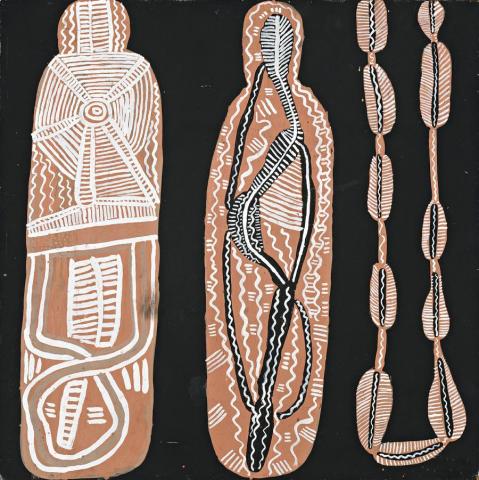UNTITLED (DINGO CEREMONY), 1971-72
Mick Namarari Tjapaltjarri
synthetic polymer powder paint on composition board
51.0 x 51.0 cm
Painted at Papunya, Northern Territory, 1971–72
Stuart Art Centre, Alice Springs (painting number 20 from consignment 8)
Private collection, South Australia
Sotheby's, Melbourne, 9 July 2001, lot 133
Private collection Sotheby's, Sydney, 28–29 July 2003, lot 231
Private collection, New South Wales
Bardon, G. and Bardon, J., Papunya, A Place Made After The Story, The Beginnings of the Western Desert Painting Movement, The Miegunyah Press, Melbourne University Publishing, 2004, p. 256 (illus. as painting 180)
For a discussion of the Fire, Spirit, Myth and Medicine Dreamings theme see Bardon and Bardon, 2004, pp. 51–52 and p. 62 (Map 9) for a detailed map of the artist's country (homeland).
Mick Namarari Tjapaltjarri's works are brimming with symbolism which is closely tied to narrative; a dense and tightly coded abstraction which elegantly refers to his key stories in ever greater loops. Western Desert painting operates within the space between ceremony and country, referencing each whilst exploring ancestral inheritance. Namarari developed a visual language which was bound by cultural protocol but never restrained by it.
The artist was born in sandhill country at Marnpi Rockhole, near the Mount Rennie Bore. After the death of both of his parents Tjapaltjarri and his sister were raised by other members of the family. Tjapaltjarri attended school at the Hermannsburg mission until he was eleven years old, when he was initiated in the Areyonga region and worked in the cattle industry. He adopted the middle name 'Namarari' after his employer MacNamara, the name echoing one of his totems, the mallee fowl.
Tjapaltjarri was one of the founding members at Papunya Tula Artists and served as a councillor on the Papunya Council. In 1991 he was awarded the National Aboriginal Art Award, a moment which heralded not only public attention for the Papunya Tula artists, but also confirmed the importance of his practice within the community. In 1994 Tjapaltjarri was the recipient of the Australia Council's emeritus award for indigenous artists and joint winner of the Red Ochre Award.
This work was completed in the second year of the Papunya painting movement. A depiction of the Dingo Ceremony, this painting is distinguished by three forms; a looped pat terned hairpiece, two ceremonial objects depicting body paint and a disguised ceremonial hat. Elegantly condensed, the painting symbolises the journeys of the Dingo ancestral men and women whose acts may only be known by a select few.
